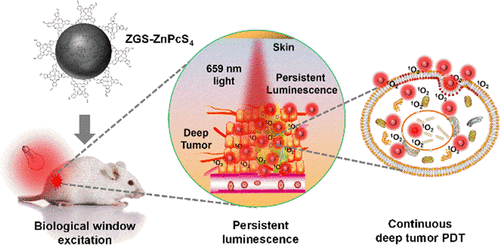当前位置:
X-MOL 学术
›
ACS Appl. Bio Mater.
›
论文详情
Our official English website, www.x-mol.net, welcomes your
feedback! (Note: you will need to create a separate account there.)
Tin-Doped Near-Infrared Persistent Luminescence Nanoparticles with Considerable Improvement of Biological Window Activation for Deep Tumor Photodynamic Therapy
ACS Applied Bio Materials ( IF 4.6 ) Pub Date : 2020-07-28 , DOI: 10.1021/acsabm.0c00644 Junpeng Shi 1, 2 , Xia Sun 3 , Shenghui Zheng 4 , Liang Song 1, 2 , Fangrong Zhang 5 , Tobias Madl 5 , Yun Zhang 1, 2 , Hongwu Zhang 4 , Maochun Hong 1
ACS Applied Bio Materials ( IF 4.6 ) Pub Date : 2020-07-28 , DOI: 10.1021/acsabm.0c00644 Junpeng Shi 1, 2 , Xia Sun 3 , Shenghui Zheng 4 , Liang Song 1, 2 , Fangrong Zhang 5 , Tobias Madl 5 , Yun Zhang 1, 2 , Hongwu Zhang 4 , Maochun Hong 1
Affiliation

|
The photodynamic therapy (PDT) as a promising antitumor therapy technique is greatly hampered by the low tissue penetration of light and the photothermal effect of prolonged irradiation. Near-infrared (NIR) persistent luminescence nanoparticles (NPLNPs) possess the potential for application in next-generation PDT. However, owing to the low re-excitation efficiency of NPLNPs in deep tissue, the current PDT nanoplatform based on NPLNPs is faced with the disadvantage of decreased PDT efficiency induced by persistent luminescence (PersL) decay at the lesion site. Herein, NPLNPs, Zn1.3Ga1.4Sn0.3O4:Cr3+ (ZGS), with small particle sizes and excellent optical properties are synthesized via a simple acetylacetonate combustion method. The ZGS can be repeatedly excited by the biological window (659 nm) light to produce a strong NIR (700 nm) PersL. The response efficiency of ZGS to the wavelength in the biological window has been greatly improved by doping Sn4+ into the ZnGa2O4 matrix, which is 55 times higher than that of traditional ZnGa2O4:Cr3+. We further develop a PDT nanoplatform by modifying a photosensitizer on its surface. The PDT experiments show that the developed nanoplatform can achieve continuous and efficient tumor PDT with a depth of up to 3 cm by repeated excitation using a 659 nm LED. The NPLNPs largely solve the problem of the low re-excitation efficiency after NIR PersL decay of traditional NPLNPs in deep tissue applications and will further promote the application of NIR PLNPs in the biomedical field.
中文翻译:

显着改善深部肿瘤光动力治疗生物窗激活的掺锡近红外持久发光纳米粒子
光动力疗法(PDT)作为一种有前途的抗肿瘤治疗技术受到光的低组织穿透性和长时间照射的光热效应的极大阻碍。近红外 (NIR) 持久发光纳米粒子 (NPLNPs) 具有在下一代 PDT 中的应用潜力。然而,由于 NPLNPs 在深部组织中的再激发效率较低,目前基于 NPLNPs 的 PDT 纳米平台面临着病变部位持续发光(PersL)衰减导致 PDT 效率降低的缺点。这里,NPLNPs,Zn 1.3 Ga 1.4 Sn 0.3 O 4 :Cr 3+(ZGS)具有小粒径和优异的光学性能,是通过简单的乙酰丙酮燃烧法合成的。ZGS 可以被生物窗口 (659 nm) 光反复激发以产生强 NIR (700 nm) PersL。通过将Sn 4+掺杂到ZnGa 2 O 4基体中, ZGS对生物窗波长的响应效率大大提高,比传统的ZnGa 2 O 4 :Cr 3+提高了55倍. 我们通过在其表面修饰光敏剂进一步开发了 PDT 纳米平台。PDT实验表明,所开发的纳米平台通过使用659 nm LED的重复激发,可以实现深度达3 cm的连续高效肿瘤PDT。NPLNPs在很大程度上解决了传统NPLNPs在深部组织应用中NIR PersL衰减后再激发效率低的问题,将进一步推动NIR PLNPs在生物医学领域的应用。
更新日期:2020-09-21
中文翻译:

显着改善深部肿瘤光动力治疗生物窗激活的掺锡近红外持久发光纳米粒子
光动力疗法(PDT)作为一种有前途的抗肿瘤治疗技术受到光的低组织穿透性和长时间照射的光热效应的极大阻碍。近红外 (NIR) 持久发光纳米粒子 (NPLNPs) 具有在下一代 PDT 中的应用潜力。然而,由于 NPLNPs 在深部组织中的再激发效率较低,目前基于 NPLNPs 的 PDT 纳米平台面临着病变部位持续发光(PersL)衰减导致 PDT 效率降低的缺点。这里,NPLNPs,Zn 1.3 Ga 1.4 Sn 0.3 O 4 :Cr 3+(ZGS)具有小粒径和优异的光学性能,是通过简单的乙酰丙酮燃烧法合成的。ZGS 可以被生物窗口 (659 nm) 光反复激发以产生强 NIR (700 nm) PersL。通过将Sn 4+掺杂到ZnGa 2 O 4基体中, ZGS对生物窗波长的响应效率大大提高,比传统的ZnGa 2 O 4 :Cr 3+提高了55倍. 我们通过在其表面修饰光敏剂进一步开发了 PDT 纳米平台。PDT实验表明,所开发的纳米平台通过使用659 nm LED的重复激发,可以实现深度达3 cm的连续高效肿瘤PDT。NPLNPs在很大程度上解决了传统NPLNPs在深部组织应用中NIR PersL衰减后再激发效率低的问题,将进一步推动NIR PLNPs在生物医学领域的应用。


















































 京公网安备 11010802027423号
京公网安备 11010802027423号